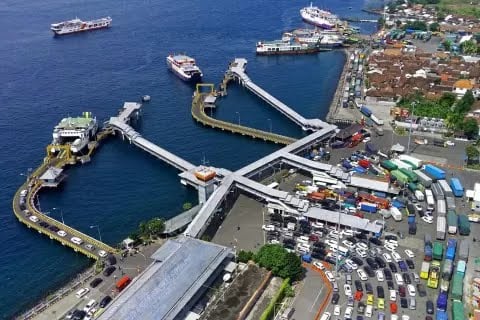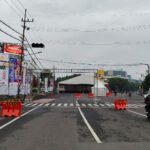The East Java Provincial Government is urging the Ministry of Transportation to immediately increase ferry capacity on the Ketapang-Gilimanuk route. This measure follows growing queues, particularly of heavy trucks, caused by reduced vessel operations.
The Head of East Java’s Transportation Department stated that Governor Khofifah Indar Parawansa has sent an official letter to the Minister of Transportation regarding the emergency situation at Ketapang Port in Banyuwangi.
“The official letter will be sent on Monday. However, we’ve already initiated communication via WhatsApp with the Director General of Sea Transportation and ASDP’s Transportation Director,” the official said.
The sharp reduction in operating vessels occurred after the sinking of the KMP Tunu Pratama Jaya on July 2, 2025. From 15 vessels previously serving the Ketapang-Gilimanuk route, only 6 have received operational permits.
Shipping safety authorities imposed these restrictions as part of a comprehensive evaluation. The impact is significant: Landing Craft Tank (LCT) vessels that typically carry large trucks are now only permitted to transport a quarter of their original capacity.
“Vessels that could previously carry 20 vehicles can now only transport 5. With only six vessels operating, this naturally creates long queues,” the official explained.
The reduced capacity and number of vessels force heavy vehicles, especially trucks with three or more axles, to wait for hours or even days. Some queues reportedly stretch dozens of kilometers, disrupting inter-regional logistics.
The situation worsens due to long turnaround times for LCT vessels. After unloading in Gilimanuk, vessels must return to Ketapang before loading other trucks.
As an additional solution, Governor Khofifah has proposed reactivating Jangkar Port in Situbondo. However, this port would specifically serve trucks weighing under 40 tons that have passed the Sedarum weighbridge in Pasuruan.
“Before entering Alas Baluran, we propose ferry route deviation from Jangkar directly to Gilimanuk, specifically for large-capacity vessels,” the official stated.
Although Ketapang Port is managed by PT ASDP Indonesia Ferry, with vessel operational permits controlled by the Tanjung Wangi Harbor Master and Director General of Land Transportation, the East Java Provincial Government emphasizes they cannot remain passive.
“This concerns national logistics flow and East Java residents’ mobility. Therefore, we must take action,” the official stressed.
The provincial government claims to maintain intensive communication with the Land Transportation Management Agency (BPTD) for East Java-Bali Region XI to expedite follow-up on the governor’s letter.
Ketapang Port
Ketapang Port is a key seaport located in Ketapang, West Kalimantan, Indonesia, serving as a vital hub for trade and transportation between Kalimantan and other Indonesian islands. Historically, it has facilitated the export of local commodities like rubber, timber, and palm oil, contributing to the region’s economy. The port also connects to nearby regions, including Java, via ferry services, enhancing regional connectivity and tourism.
Gilimanuk
Gilimanuk is a coastal town in West Bali, Indonesia, known for its ferry port that connects Bali to Java. Historically, it was an important trading post and is also significant for its archaeological site, Gilimanuk Ancient Cemetery, which dates back to the Bronze Age and reveals artifacts and human remains from Bali’s prehistoric era. Today, the town serves as a key transportation hub while preserving its cultural and historical heritage.
KMP Tunu Pratame Jaya
There is limited publicly available information about *KMP Tunu Pratame Jaya*, but it appears to be an Indonesian vessel (KMP stands for *Kapal Motor Penumpang*, or passenger motor ship). Such ships are commonly used for inter-island transportation in Indonesia, though specific historical or operational details about this particular vessel are unclear. If it serves a cultural or historical role, further local sources or maritime records may provide additional context.
Jangkar Port
Jangkar Port, located in East Kalimantan, Indonesia, is a historically significant trading hub that played a key role in regional commerce, particularly during the colonial era. Originally used by indigenous communities and later developed by Dutch colonizers, it facilitated the export of local resources like timber and coal. Today, it remains an important port for economic activities in Borneo.
Situbondo
Situbondo is a regency in East Java, Indonesia, known for its scenic landscapes, including beaches, plantations, and the Baluran National Park. Historically, it was an important area during the Dutch colonial era due to its strategic location and fertile land for agriculture, particularly sugar cane and tobacco. Today, Situbondo blends cultural heritage with natural attractions, offering a glimpse into Java’s rural life and colonial past.
Sedarum weighbridge
The Sedarum Weighbridge is a historical site in Malaysia, traditionally used to measure the weight of goods transported by river, particularly during the tin mining era in the 19th and early 20th centuries. Located near the Sedarum River, it played a key role in trade and taxation, ensuring accurate measurements for merchants and colonial authorities. Today, it stands as a reminder of Malaysia’s mining heritage and economic history.
Alas Baluran
Alas Baluran, also known as Baluran National Park, is a protected area located in East Java, Indonesia, often referred to as “Indonesia’s Little Africa” due to its savanna landscape and diverse wildlife. Established in 1980, the park covers around 25,000 hectares and is home to species such as Javan leopards, water buffalo, and deer, alongside unique flora. Historically, the area was once a dense forest but transitioned into savanna due to volcanic activity and fires, creating its distinctive ecosystem.
Tanjung Wangi Harbor
Tanjung Wangi Harbor is a scenic port located in Banyuwangi, East Java, Indonesia, known for its stunning views of the Bali Strait and Mount Ijen. Historically, it has served as a vital transportation and trade link between Java and Bali. Today, it is a popular spot for tourists, offering ferry services to Bali and serving as a gateway to nearby natural attractions like the Ijen Crater.





